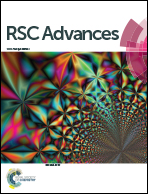Synthesis and characterization of amidoxime modified calix[8]arene for adsorption of U(vi) in low concentration uranium solutions†
Abstract
A novel calixarene derivative, amidoxime group modified calix[8]arene (C8A-AO), was synthesized from the nitrile group modified calix[8]arene (C8A-CN), and then the nitrile group was changed into an amidoxime group by treating with hydroxylamine under alkaline solution. The products were characterized by nuclear magnetic resonance (NMR), Fourier transform infrared (FT-IR) spectroscopy, field-emitting scanning electron microscopy (FE-SEM), X-ray photoelectron spectroscopy (XPS), elemental analysis and thermogravimetric analysis (TGA). The prepared C8A-AO was applied to adsorb U(VI) in low concentration uranium solutions, less than 1 mg L−1. The effects of pH, contact time, initial concentration, and temperature on the sorption of U(VI) on C8A-AO were investigated. The adsorption efficiency of U(VI) on C8A-AO reached more than 95% in neutral solution. The results showed the adsorbent C8A-AO had an excellent distribution coefficient (Kd) when the initial uranium concentration was less than 1 mg L−1. Additionally, the adsorption results revealed that the kinetics of U(VI) adsorption followed a pseudo-second-order model and the adsorption isotherm fitted well with the Langmuir model. The results of thermodynamic parameters showed that the adsorption process of U(VI) was spontaneous, feasible and endothermic. Furthermore, the excellent selective adsorption capability of U(VI) in simulated seawater suggested that C8A-AO was a potential adsorbent for recovery of U(VI) from seawater.
![Graphical abstract: Synthesis and characterization of amidoxime modified calix[8]arene for adsorption of U(vi) in low concentration uranium solutions](/en/Image/Get?imageInfo.ImageType=GA&imageInfo.ImageIdentifier.ManuscriptID=C6RA23764A&imageInfo.ImageIdentifier.Year=2016)


 Please wait while we load your content...
Please wait while we load your content...